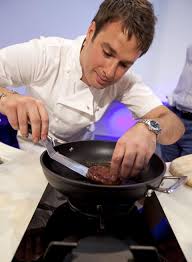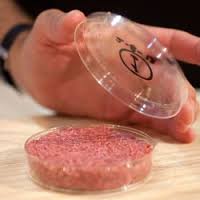Grown in a laboratory, fully constructed and engineered, made from almost nothing: the burger, the Franken-Burger. It’s lab-made from cow cells and supposed to solve our problems, running to our rescue to cure the planet of starvation and provide the people with the manna from heaven. In twenty years from now, food will be engineered, grown in laboratories and packaged to be distributed to the populations. Well, perhaps not to everyone. Only to those that can pay for it at the price it comes at and anyhow, judging but what’s inside it the ones who eat it won’t be around for too long after the chew on the first lump of steak.
The first public tasting of the engineered burger took place in London yesterday. Mark Post has been leading research undertaken at the University of Maastricht in the Netherlands and it was backed by the founder of Google,Sergey Brin. The Google billionaire stumped up more than $525, 000 to back the project and get the team of researchers to find a viable solution to the lack of food and come up with a sustainable choice to livestock farming of cattle.
The first burger that was put on show in London was a 140gr-burger made from meat fibers and beef-muscle stem cells. There were 20, 000 muscle fibers grown in a lab in that burger. The affair was international. Financed by an American, engineered by a Dutchman, cooked by a Brit and rated by an Austrian and a US food writer. Isn’t it wonderful how we can all work together? The verdict was it may have cost a lot and it may be the first and an engineering feat, but it’s dry and rather bland in taste. Or, maybe that was the English cook.
Brin said: “seems like it is on the cusp of viability and, if it succeeds ... can be really transformative for the world”. Maybe one person’s definition of transformative and another’s are not the same. Mark Post stated that this new method of production would be less demanding regarding the natural resources of the world. He went on to add that he needs to raise $13 million approximately to be able to add fat cells to the meat to improve the taste and also to introduce red myoglobin pigment before it ends up sitting on the shelves in the supermarkets. The burger took five years to get to this stage. It will take just as long before it gets onto the people’s plates.
Genetically-modified food went on sale in the world for the first time in 1994, when theFlavr Savr tomato with delayed ripening went on sale. We also have soybean, corn and canola or rapeseed oil. When you step into your local supermarket take a look at the fruit and vegetables that are on sale there just begging for you to buy them as they sit there all perfect on the shelves. They are wrinkleless, perfectly shaped, identical, highly colored and not a blemish in sight. The flawless fruit and veg are engineered to be like that, clones, imitating Mother Nature and fooling the majority of people, for a while; until you cotton on that there’s no taste, they are insipidly watery and last for days until they suddenly rot completely in a mass of fungi and mold overnight in the bottom of the fridge. The consumer demands that fruit and veg to be squeaky clean, so clean it’s dangerous, and the average shopper has become so far removed from the production process that he doesn’t even know what he’s eating. The tomatoes are grown hydroponically, planted in a block of mineral, a by-product of the insulation in the construction industry, enriched with calcium, potassium, fertilizers and nitrogen and a bit of CO2 gas thrown in for good measure. We are told that people want the look rather than the taste. Everybody has to get the same tomato. The Jones can’t outdo the Smiths anymore; we’re all equal. Pears need to be pear-shaped, apples need to be blemish-free and just the right hue of golden red; the fruit beauticians and the lab surgeons make them like that, otherwise the supermarkets reject them. 90% of apples get rejected because they are blemished or not perfect by the supermarket buyers.
The United Nations Food and Agriculture Organization states that there are an estimated 870 million people that are hungry in the world in 2013 and that means chronic undernourishment. 852 million of them live in developing countries, but that means that there are more than we can imagine in our own developed countries. It is doubtful if the invention of the lab-burger will solve anything related to hunger as we already produce enough calories for everybody on the planet to have 2, 720 kilocalories every day. World population has increased by 70% in the past 30 years, but we produce enough food to have 17 calories more than we did for each of those people every day. But, that doesn’t mean to say that we all get those calories. Hunger causes poverty and poverty causes hunger and we go round in circles. It’s poverty that is the problem and economic systems that control resources as well as climate change and meteorological conditions. We will double the quantity of meat that we eat by 2050, according to the UNFAO, and it will take up about 70% of land that is reserved for agriculture today. The engineered burger will save on water resources in the world and free agricultural land from livestock, thus reduce our environmental impact, apparently.
Animal activists that are crying out to save the animals from slaughter in the hope that we all go veggie can see a glimmer of light at the end of the tunnel, believing that this will be the end to the slaughter-houses and Daisy will live a peaceful sunbaked retirement on some prairie somewhere in the Mid-West. But, the livestock will still be the cause of o-zone-destroying methane gas and anyhow we only need a small herd to take samples from to keep on growing the burgers in the labs. Why keep the animals at all?
Next time you go into your supermarket, wonder why the fruit is dirtfree, why the cucumbers don’t curve, why the apples look like they are twins, why the carrots have no cracks and are the same length. Wonder then what the meat will look like in twenty years’ time and if we really will be doing this to save the planet from starvation.
Whether we like it or not, the future has arrived, this is Star-Treck, Star-Wars and Flash Gordon all rolled into one; we’ll be popping food pills soon and won’t even need to eat.
© 2024 Benzinga.com. Benzinga does not provide investment advice. All rights reserved.
Comments
Trade confidently with insights and alerts from analyst ratings, free reports and breaking news that affects the stocks you care about.


